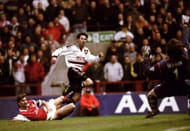Back in the day, in the 90s, corded landline phones were a thing of luxury. If a family had them, they would be the glory of the home. Almost often, they would be placed in the hall or the TV room as a means to showcase the sophistication.
After the turn of the millennium, most families owned corded landline phones. With almost everyone having them, the phones lost their aristocracy status—that belonged to the Nokia 3310 now—but they were still the prominent means of communication even at that point of time.
As time passed, technological advances meant that the phones got smart and smarter—and cheaper—and more people started owning them. The portability of the cordless mobile phones made it the de facto mode of communication amongst people.
Corded landline phones were now hiding in silence in some corner of the home, rarely ever used. Indeed, at this point of time, a household may or may not have them, but are more than likely to have more than one mobile phone.
The corded landline phone is the traditional out-and-out winger in football.
The victims of tactical innovations
Back in the 90s and the early 2000s, the likes of Luis Figo, Ryan Giggs, Roberto Donadoni and David Beckham were leading acts in their teams. They were the last of the traditional star wingers, jinxing past their marker and putting in the perfect cross for the forward to score.
However, this breed is a dying one—and the ones that still exist, aren’t really requisite players of the system like the aforementioned players were.
In the old times, the 4-4-2 was the prominent formation in both defence and attack. Even though most teams right now use the same formation to maintain a steady defensive shape, it takes a completely different form whilst in attack.
The Champions League winner for the last two years, Real Madrid, for example, use the conventional 4-4-2 when without possession of the ball and switch to a 4-3-3 or 4-3-1-2 when in possession.
Juventus, the pioneers of the 3-man backline, also use a similar strategy where they momentarily shift to a 4-4-2 in defence before taking the general shape in attack.
The job of a modern winger is much more sophisticated than it was before. Two decades ago, the winger was supposed to support his full-back in defence and then support the striker in attack, mainly with crosses. His job was predominantly supporting, scoring was never really the concern.
However, with changes in the way football is played right now, with forwards that are much more specialised than before, the position that has seen the most evolvement is the winger’s.
The archetype forward of those times was a tall aerially strong folk that could bully defenders within the box, someone like Alan Shearer. So the stratagem laid out for the wingers was simple: run past the opponent and play in the cross.
It’s not that they were always confined to doing this alone as they also played centrally at times, but providing width and crosses were the basic duties of the winger.
The forwards right now are more specialised than the all-round player that Shearer was. With the rise of tactical variances like using goalscorers on the wings and asking them to cut inside while the striker drops to become the trequartista , the traditional winger has become the ultimate casualty.
During the golden years of Barcelona, the trio of Thierry Henry, Lionel Messi and Samuel Eto’o combined to score over a 100 goals in their treble winning season. All of these players were specialised forwards taking up the front three spots. Had they played for three different teams, they would be the striker in each of them.
And now we have the MSN, Messi-Suarez-Neymar, another trio of players where two are essentially forwards shunted on the wings to maximise the scoring potential. Almost every club uses this strategy right now—and why wouldn’t they? It works.
The job of the winger in the tactical sense is to provide width to the system. Flirting with the touchline is basically the job description of a winger. However, with the rise of the attacking full-back, the job of providing width is no longer mandatory.
Full-backs these days are more wing-backs, they attack as much as they defend. The holding midfielder drops deep to push the centre-halves out and full-backs up above on the pitch. They are the width-providers, so using traditional wingers while having attacking full-backs is sort of redundant.
Hence, wingers are expected to be more involved centrally.
Football systems in the olden days were very basic. Defenders, including the full-backs, were only meant to defend. The central midfielders were expected to guard the defence while setting the tempo. The wingers were instructed to provide width and support both attack and defence while the forwards would score.
Now, with tactical innovations changing the way the game is played, the classic traditional winger no longer fits the bill. The rise of Gareth Bale gave birth to a hope that maybe, just maybe, the traditional winger will resurge in a much more stronger way, but his move to Real Madrid and subsequent change of positions killed those hopes.
There are a few players that play in the traditional wide midfielder, the likes of, say, Lucas Vazquez. But, as is the case with Vazquez, they are more of a super-sub to mix things up in the park than indispensable cogs in the system.
And that’s what they shall be for a considerable amount of time: the bit-part player.



